Calyptratae
| Calyptratae Temporal range: | |
|---|---|

| |
| Scientific classification | |
| Domain: | Eukaryota |
| Kingdom: | Animalia |
| Phylum: | Arthropoda |
| Class: | Insecta |
| Order: | Diptera |
| Clade: | Eremoneura |
| (unranked): | Cyclorrhapha |
| Section: | Schizophora |
| Subsection: | Calyptratae |
| Superfamilies | |
Calyptratae is a subsection of Schizophora in the insect order Diptera, commonly referred to as the calyptrate muscoids (or simply calyptrates). It consists of those flies which possess a calypter that covers the halteres, among which are some of the most familiar of all flies, such as the house fly.
About 18,000 described species are in this group, or about 12% of all the flies yet described.[1]
Subsection
- Superfamily Muscoidea
- Anthomyiidae - cabbage flies
- Fanniidae
- Muscidae - house flies
- Scathophagidae - dung flies
- Superfamily Oestroidea
- Superfamily Hippoboscoidea
The Mormotomyiidae belong to the Ephydroidea and not to Hippoboscoidea as previously construed.[3] The Streblidae are probably not monophyletic.[4]
References
- '^ Kutty, Sujatha Narayanan; Pape, Thomas; Wiegmann, Brian M.; Meier, Rudolf (2010). "Molecular phylogeny of the Calyptratae (Diptera: Cyclorrhapha) with an emphasis on the superfamily Oestroidea and the position of Mystacinobiidae and Mc Alpines fly". Systematic Entomology. 35 (4): 614–635. doi:10.1111/j.1365-3113.2010.00536.x.
- ^ Michelsen, Verner; Pape, Thomas (2017). "Ulurumyiidae – a new family of calyptrate flies (Diptera)". Systematic Entomology. 42 (4): 826–836. doi:10.1111/syen.12252. S2CID 90058240.
- ^ Kirk-Spriggs, A.H., Kotrba, M. & Copeland, R.S. 2011. Further details of the morphology of the enigmatic African fly Mormotomyia hirsuta Austen (Diptera: Mormotomyiidae). African Invertebrates 52 (1): 145-165."Archived copy". Archived from the original on 2011-10-04. Retrieved 2011-10-04.
{{cite web}}: CS1 maint: archived copy as title (link) - ^ Petersen, Frederik Torp; Meier, Rudolf; Kutty, Sujatha Narayanan & Wiegmann, Brian M. (2007): The phylogeny and evolution of host choice in the Hippoboscoidea (Diptera) as reconstructed using four molecular markers. Mol. Phylogenet. Evol. 45(1): 111–122. doi:10.1016/j.ympev.2007.04.023 (HTML abstract)
